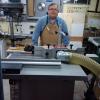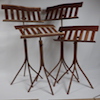I know this is somewhat basic, but Iím inexperienced with transformers and looking for some confirmation / advice. I have a few questions about adding in a 440V machine to my 240V system.
I have a 10 HP Kay Phasemaster RPC thatís fed 60 amps single phase at 240V and has a 30 amp 3 phase receptacle on output side. This runs my planer, one of my table saws, and a shaper (one at a time.) I have gathered all the parts and pieces for a 125 amp 3 phase MLO panel on the output side with a 20 amp circuit (shaper power feed, drill press) and a 30 amp circuit (planer, table saw, shaper) The wiring/installation for all this is about to begin.
I am soon adding a Solberga drill press with a 2 speed motor that is 440V only. The motor tag says 2.0 amps at 440V. It does not appear to be a dual voltage motor and I think this is fairly common with these presses to have it be only 440V.
I donít plan to add anymore 440V machines, but...
What size transformer do I need to run the drill press? According to my napkin math, a 2.5kV transformer would do it, but I may be miscalculating.
Aside from eBay and Craigslist and asking my electrician neighbor, where are you guys finding surplus transformers. Iím hoping to find something for less than $250-300 semi locally.
Where do I add the transformer past the RPC? Obviously I still want 240V 3 phase for all the other machines. Maybe I should add a second 20 amp circuit / breaker in the MLO that is dedicated to 440v with a transformer downstream of that?
It seems that most transformers are meant to step down voltage instead of step up. Can they be wired ďbackwardsĒ in this case without any practical issues?
I can afford to wait a little bit (month or so) for a good deal to surface on what I need, but much more than that and Iíll be getting antsy and needing to have the press running.
What else do I need to know that I am overlooking as far as transformers go?
Thanks so much for any input.
-Phillip




 Reply With Quote
Reply With Quote




